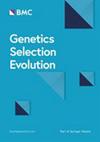Genome-wide association studies and genetic architecture of carcass traits in Angus beef cattle using imputed whole-genome sequences data
IF 3.1
1区 农林科学
Q1 AGRICULTURE, DAIRY & ANIMAL SCIENCE
引用次数: 0
Abstract
Carcass related traits are economically important traits for the beef industry, which affect quantity, quality and pricing of meat and farmers profitability. The current study was carried out to identify genomic regions associated with carcass traits including carcass weight (CW), marbling score (MS), rib-eye area (REA), and back fat thickness (BFT). Genome-wide association studies (GWAS) were performed using linear mixed models on 6,511,978 imputed whole genome sequence (WGS) variants in a population of 13,241 Angus beef cattle. The genetic architecture of the traits was evaluated based on the GWAS results. With a threshold of p-value < 3.96 × 10–7, 842, 745, 340, and 101 SNPs located in 13 genomic regions were significantly associated with CW, MS, REA, and BFT, respectively. While the majority of the identified quantitative trait loci (QTL) were trait-specific, two QTLs with pleiotropic effect were identified, including a QTL on BTA7 (88.25–91.96 Mb) affecting CW, MS and REA, and a QTL on BTA20 (4.55–5.01 Mb) affecting CW and BFT. Several important genes are harbored by the detected QTLs, which can be considered potential candidate genes for carcass traits in Angus beef cattle. Our findings also showed that higher density panels are more powerful in GWAS, such that the signals on BTA6 affecting CW, and two signals on BTA17 and BTA18 affecting MS were not detectable using medium SNP array genotypes. The allele substitution effects and additive genetic variances of the imputed variants followed a bell-shaped and a scaled inverse chi-squared distribution, respectively. Among functional categories, missense variants had the highest allele substitution effects for CW, MS and BFT, while 3′ UTR variants had higher effects for REA, compared to other functional classes. Our findings highlight the power of using imputation to perform GWAS and provide some valuable information for a better understanding of the underlying genetic background and architecture of carcass traits in beef cattle.基于全基因组序列数据的安格斯肉牛胴体性状全基因组关联研究和遗传结构
胴体相关性状是牛肉产业重要的经济性状,影响肉品的数量、质量和价格以及养殖户的盈利能力。本研究旨在确定与胴体性状相关的基因组区域,包括胴体重(CW)、大理石纹评分(MS)、肋眼面积(REA)和背部脂肪厚度(BFT)。采用线性混合模型对13241只安格斯肉牛的6511978个全基因组序列(WGS)变异进行了全基因组关联研究(GWAS)。根据GWAS结果对性状的遗传结构进行评价。在p值< 3.96 × 10-7的阈值范围内,13个基因组区域中的842、745、340和101个snp分别与CW、MS、REA和BFT显著相关。虽然大多数QTL是性状特异性的,但鉴定出2个具有多效性的QTL,包括影响CW、MS和REA的BTA7 QTL (88.25 ~ 91.96 Mb)和影响CW和BFT的BTA20 QTL (4.55 ~ 5.01 Mb)。检测到的qtl包含了几个重要的基因,可以认为是安格斯肉牛胴体性状的潜在候选基因。我们的研究结果还表明,密度越大的面板在GWAS中作用越强,因此使用中等SNP阵列基因型无法检测到BTA6上影响CW的信号,以及BTA17和BTA18上影响MS的两个信号。输入变异的等位基因替代效应和加性遗传方差分别服从钟形分布和比例反卡方分布。在功能类别中,错义变异对CW、MS和BFT的等位基因替代效应最高,而3 ' UTR变异对REA的等位基因替代效应高于其他功能类别。我们的研究结果强调了使用归算执行GWAS的力量,并为更好地理解肉牛胴体性状的潜在遗传背景和结构提供了一些有价值的信息。
本文章由计算机程序翻译,如有差异,请以英文原文为准。
求助全文
约1分钟内获得全文
求助全文
来源期刊

Genetics Selection Evolution
生物-奶制品与动物科学
CiteScore
6.50
自引率
9.80%
发文量
74
审稿时长
1 months
期刊介绍:
Genetics Selection Evolution invites basic, applied and methodological content that will aid the current understanding and the utilization of genetic variability in domestic animal species. Although the focus is on domestic animal species, research on other species is invited if it contributes to the understanding of the use of genetic variability in domestic animals. Genetics Selection Evolution publishes results from all levels of study, from the gene to the quantitative trait, from the individual to the population, the breed or the species. Contributions concerning both the biological approach, from molecular genetics to quantitative genetics, as well as the mathematical approach, from population genetics to statistics, are welcome. Specific areas of interest include but are not limited to: gene and QTL identification, mapping and characterization, analysis of new phenotypes, high-throughput SNP data analysis, functional genomics, cytogenetics, genetic diversity of populations and breeds, genetic evaluation, applied and experimental selection, genomic selection, selection efficiency, and statistical methodology for the genetic analysis of phenotypes with quantitative and mixed inheritance.
 求助内容:
求助内容: 应助结果提醒方式:
应助结果提醒方式:


